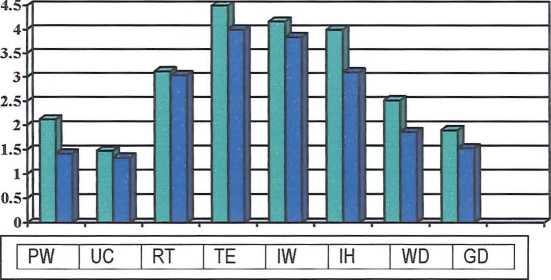148
Table 4.3.24: Comparison between 8th grade teachers and their pupils; deployment
|
8th grade teachers____________ |
8th graders_____________________ |
Effect size d___________________ | |
|
Practical work |
M=2.12, SD=. 86 |
M=1.42, SD=. 61 |
1.15 |
|
Individual help |
M=4.00, SD=. 86_______ |
M=3.10, SD=1.09 |
.83____________________ |
|
Whole-class discussion |
M=2.52, SD=1.13 |
M=1.86, SD=. 94_______ |
.70_____________________ |
Figure 4.3.20: Comparison between 8th grade teachers and their pupils; perceptions of
deployment

□ Teachers (Sth)
□ Sth graders
PW = Practical work, UC = Using a ∞mputer, RT= Reading a textbook, TE = Teacher explanation,
IW = Individual work, IH = Individual help, WD = Whole-class discussion, GD = Group discussion
Summary
The results of the data analysis show that 8th grade teachers were likely to have stronger
perceptions of the frequency of the deployment of all teaching methods, and the extent
to which these teaching methods promoted pupils’ affective attitudes, than their pupils.
The differences were particularly strong in the case of Practical work, Individual help and
Whole-class discussion.
4.3.5: Summary of 4.3
The findings reported in this section have shown that:
• Practical work, Whole-class discussion and Group discussion were more likely to be
deployed and preferred by teachers of 5th graders than teachers of 8th graders.
• Practical work, Using a computer, Reading a textbook, Whole-class discussion and
Group discussion were perceived as being more frequently being deployed and more
preferred by 5th graders than 8th graders.
148
More intriguing information
1. Group cooperation, inclusion and disaffected pupils: some responses to informal learning in the music classroom2. Reversal of Fortune: Macroeconomic Policy, International Finance, and Banking in Japan
3. Evaluating the Impact of Health Programmes
4. On the Desirability of Taxing Charitable Contributions
5. The name is absent
6. Housing Market in Malaga: An Application of the Hedonic Methodology
7. The name is absent
8. The name is absent
9. Les freins culturels à l'adoption des IFRS en Europe : une analyse du cas français
10. The name is absent